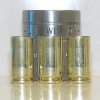Blazerbowe
Member
Still fairly new to reloading, but getting better and better each time out. One of the best bits of advice I got from this forum was using the "plunk test" to help with determining proper OAL. This has helped immensely. My question, however is this:
Loaded a new batch of 185 gr Hornady XTP .45 acp rounds last night. My brass is a mix of my own once-fired brass (a mix of Remmington and Winchester mostly). I seated the rounds to a consistent 1.200" OAL. After finishing 100 rnds, I used the barrel of my Kahr to perform the "Plunk-Test".... just to see. 95% of the rounds I made performed perfect. A handful, however, would not slide in more than half way. With pressure, they would seat. But definitely not a plunk.
Just curious at to what usually is the cause of this? Is it just a bad piece of brass? Or is there something else that can cause this that I'm not seeing. Micrometer measures are all pretty much identical.... but a few rounds just don't plunk. Not terribly worried.... just looking for knowledge. Thx!
Loaded a new batch of 185 gr Hornady XTP .45 acp rounds last night. My brass is a mix of my own once-fired brass (a mix of Remmington and Winchester mostly). I seated the rounds to a consistent 1.200" OAL. After finishing 100 rnds, I used the barrel of my Kahr to perform the "Plunk-Test".... just to see. 95% of the rounds I made performed perfect. A handful, however, would not slide in more than half way. With pressure, they would seat. But definitely not a plunk.
Just curious at to what usually is the cause of this? Is it just a bad piece of brass? Or is there something else that can cause this that I'm not seeing. Micrometer measures are all pretty much identical.... but a few rounds just don't plunk. Not terribly worried.... just looking for knowledge. Thx!



